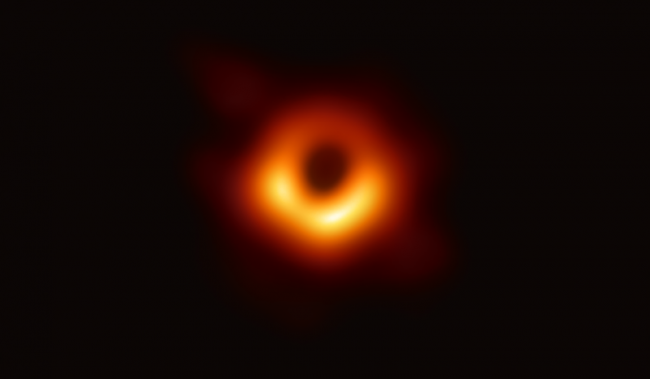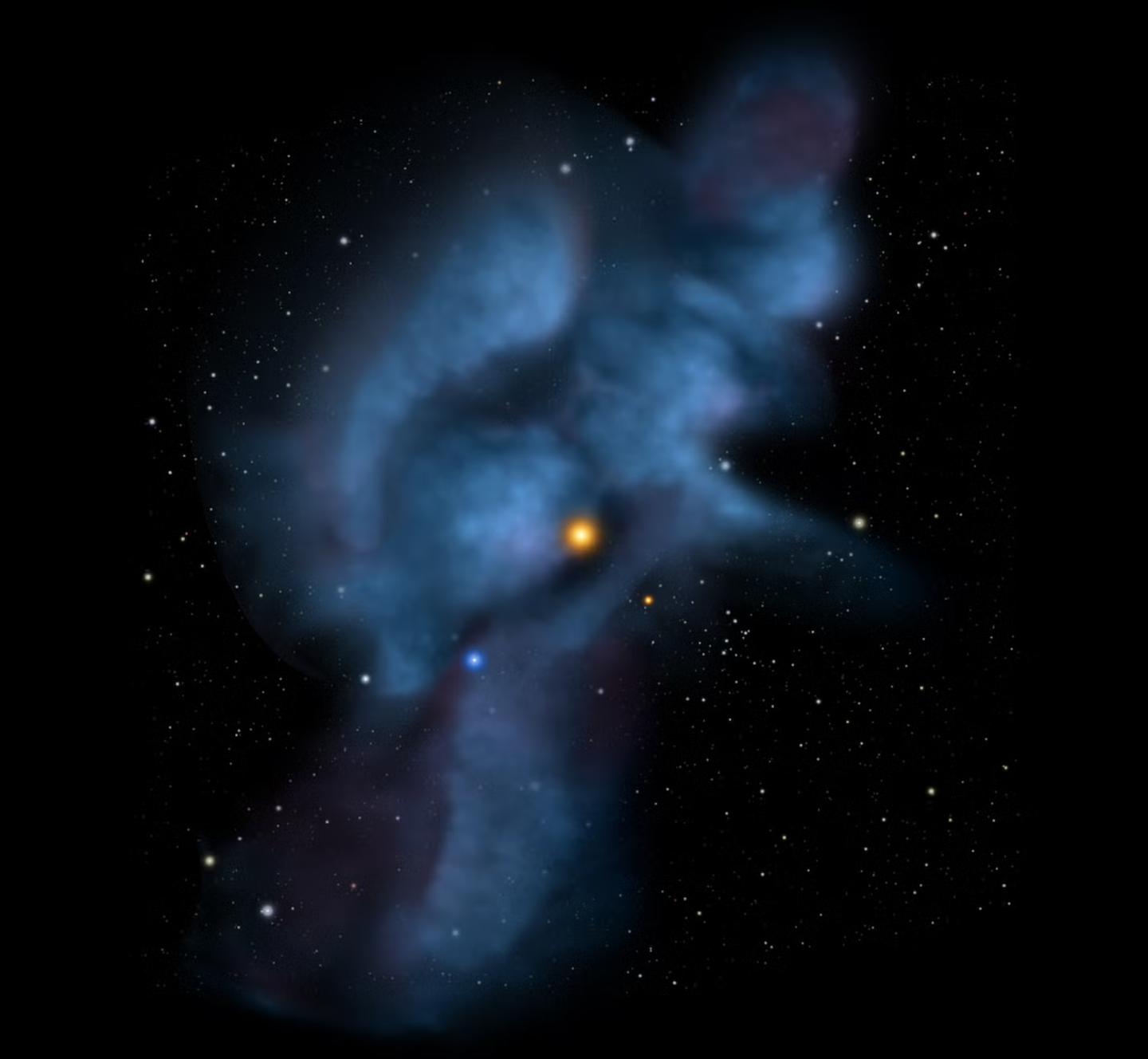Scientists capture sharpest-ever black hole images taken from Earth
In a major leap forward, scientists, using the Event Horizon Telescope (EHT), have captured the sharpest images yet of distant galactic centers.

The first image of a black hole in human history, captured by the Event Horizon Telescope, showing light emitted by matter as it swirls under the influence of intense gravity. This black hole is 6.5 billion times the mass of the Sun and resides at the center of the galaxy M87. (CREDIT: Event Horizon Telescope Collaboration)
In a major leap forward, scientists, using the Event Horizon Telescope (EHT), have captured the sharpest images yet of distant galactic centers. Using light at a frequency of 345 GHz, they’ve peered deeper into the regions around black holes than ever before. This marks the first time such high-frequency observations have been achieved by the team behind a global telescope network.
The achievement comes from a powerful technique called very long baseline interferometry. By combining signals from telescopes scattered across the planet, scientists effectively created a single instrument the size of Earth. This “virtual” telescope allows for incredibly fine detail, letting researchers zoom in on the most extreme environments in space.
For the first time, signals at 345 GHz were successfully detected from these cosmic giants. This is a notable jump from the team’s earlier work at 230 GHz. The shorter wavelength allows for greater angular resolution—around 14 microarcseconds—nearly 50% sharper than previous efforts. This means scientists can now see how light bends near the powerful gravity of supermassive black holes with more clarity.
Among the most studied black holes are those in the galaxy known as M87 and one at the center of our own. With this finer lens, researchers hope to uncover subtle details about their behavior. The swirling gas, intense gravity, and strong magnetic fields that shape their surroundings are coming into focus in ways never before possible.
This sharper view opens the door to new discoveries. Back in 2019, the same network captured the first direct image of a black hole at a lower frequency. While those images were revolutionary, they hit a wall in terms of detail. Now, with higher-frequency data, the scientific team can begin to separate the influence of different forces at play.
“At 345 GHz, our images will be sharper and more detailed,” said Alexander Raymond, co-lead on the paper and a former researcher at the Center for Astrophysics. “This, in turn, will likely reveal new properties, both those that were previously predicted and maybe some that weren’t.”
Related Stories
Achieving the high resolution possible with VLBI at 345 GHz, however, presented unique challenges. Although observing single telescopes at this frequency had been feasible, adapting VLBI to 345 GHz required advances in technology. At this frequency, atmospheric water vapor absorbs radio waves much more intensely than at lower frequencies, significantly weakening signals from distant black holes.
To combat this, the EHT collaboration enhanced its bandwidth, which allowed researchers to capture wider swaths of the radio spectrum. Furthermore, researchers had to wait for near-perfect weather conditions across all telescope sites, each of which operates at high altitudes to minimize atmospheric interference.
The success of these new observations was also dependent on the quality and locations of the telescopes within the EHT array. High-altitude sites such as the Atacama Large Millimeter/submillimeter Array (ALMA) and the Submillimeter Array (SMA) in Hawaiʻi are instrumental in mitigating atmospheric opacity and ensuring stability during measurements.
“The most powerful observing locations on Earth exist at high altitudes, where atmospheric transparency and stability are optimal,” explained Nimesh Patel, an astrophysicist at CfA and SMA project engineer. Patel recounted the recent winter conditions at Maunakea, where icy roads had to be cleared minutes before opening the array to ensure data collection during brief windows of stable weather.
Expanding EHT’s capabilities to the 870-micrometer range has opened doors for several scientific advancements. In addition to clearer images, these observations provide insights into the polarized light around black holes. At higher frequencies, Faraday rotation—a phenomenon that alters the orientation of light’s electric field as it travels through a magnetized medium—becomes less pronounced, enabling a more precise view of black hole magnetic fields.
This is especially significant for understanding the magnetic environment surrounding Sagittarius A*, which is influenced by interstellar scattering that diminishes with higher frequencies. By reducing these scattering effects, the EHT can now observe structures as intricate as photon rings, which form when light orbits around the black hole’s event horizon. This is the first step toward observing these rings, an outcome expected to yield unprecedented insights into black hole dynamics.
The achievement also sets the stage for creating time-lapse “movies” of black hole environments. Since Sagittarius A* has a dynamic timescale of about 200 seconds, simultaneous observations at 1.3 mm and 870 micrometers could soon allow real-time imaging of material moving around the event horizon.
For M87*, which evolves over a longer timescale of about three days, images collected over consecutive days could be combined to form detailed time-lapse visualizations of its active surroundings. Developing such time-lapse imagery relies on future upgrades to the EHT’s global array, which includes plans for the next-generation EHT (ngEHT) project.
This ambitious endeavor aims to expand the EHT’s telescope network, adding new antennas in optimal locations worldwide to achieve coverage at multiple frequencies between 100 and 345 GHz. With these enhancements, the array will gather ten times more high-quality data, empowering scientists to capture both sharper and more detailed images.
Beyond imaging the black holes at M87 and Sagittarius A*, the enhanced 870-micrometer capabilities also allow the EHT to observe other active galactic nuclei (AGN) jets with greater precision. The finer resolution makes it possible to study jet formation and acceleration closer to black holes, as well as to investigate features like limb-brightening, which occurs in the jet's inner regions.
Janssen and colleagues, for example, noted that jets often show increased brightness near their edges, a phenomenon poorly understood due to the limited resolution of prior observations. With the new 870-micrometer capabilities, scientists can now study these and other features of AGN jets with the level of detail needed to clarify how these jets originate and propagate across galactic distances.
The ngEHT project’s advancements could also help astrophysicists build a high-fidelity “movie” of accretion and jet launching mechanisms. Multifrequency synthesis (MFS), a technique that combines data from different frequencies, will allow astronomers to map black hole environments in detail over time.
For Sagittarius A*, the MFS technique can provide a real-time glimpse into the black hole's turbulent surroundings, capturing kinematic changes near the event horizon. In the case of M87*, a longer-period dynamical timescale means that high-fidelity images collected over multiple days can be stitched together to create time-lapse footage, offering fresh insights into this supermassive black hole’s activity.
This technological leap forward represents more than just an improvement in resolution—it is a testament to the determination and collaborative spirit within the EHT project, which has transformed ground-based black hole observation. By surmounting the technical hurdles of observing at higher frequencies, the EHT has redefined the boundaries of what is possible in astrophysical research.
“The EHT’s successful observation at 345 GHz is a major scientific milestone,” said Lisa Kewley, Director of CfA and SAO. “By pushing the limits of resolution, we’re achieving the unprecedented clarity in the imaging of black holes we promised early on, and setting new and higher standards for the capability of ground-based astrophysical research.”
This step forward represents a major achievement for scientists seeking to unlock the mysteries of black holes and their dynamic environments. With the arrival of 345 GHz imaging, the EHT has ushered in a new era of astrophysical discovery that promises sharper, clearer, and more comprehensive views of the universe’s most unique entities.
Note: Materials provided above by The Brighter Side of News. Content may be edited for style and length.
Like these kind of feel good stories? Get The Brighter Side of News' newsletter.



